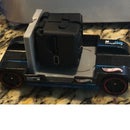Introduction: Rear Facing Car Seat Video Display
When my wife and I found out we were pregnant, my little truck had to go. When we discovered it was twins, the size of the vehicle we needed jumped too. We ending up with a used 2012 Chevrolet Traverse (which has been a great car). The car we purchased was a step up from the base model but didn't have a GPS, backup camera or bluetooth. I ordered a head unit from Simplesoft USA off Amazon for $600, that had all of the features we were looking for.
The installation of the backup camera/GPS was simple enough, but I found that months after I installed everything there was an unused auxiliary input and decided to experiment. I purchased another backup camera online and plugged it in. Sure enough, when selected off the head unit, an image came up! But of course it had green, yellow and red backup lines as an On Screen Display. I contacted the company I ordered it from off Ebay about a camera that didn't have the display, but never got any response.
In the months that followed, this basic setup helped a great deal when we had to drive long distances to visit family, but the display always bothered me. I recently discovered how to remove the lines and thought I would write up a basic install.
Step 1: Gather Materials and Tools
As I said, I purchased an LT model that did not have a display of any kind. I looked at alot of different units online but eventually went with one from SimplesoftUSA. I could not find the specific unit on Amazon any longer, but this is the link.
We both really like the GPS, install was simple and covered on Traverseforum.com.
The unused auxiliary import is designed for a DVD player or video game system in the back seat. I purchased a cheap backup camera off Ebay here for about $13. Full disclosure, I ordered a second one when I tried to replace the OSD and broke the first one when I couldn't figure out the display. The second one was a different circuit board/chip and was very simple to fix. The backup camera came with a RCA cable that was long enough to reach the head unit and display.
Materials:
Head Unit with display input
Backup Camera
Tools:
Plastic Dash Removal Tools
Hot Glue Gun
Soldering Iron
Small Phillips screw driver
Multimeter
Step 2: Disassemble Camera Remove OSD
The camera is very easy to disassemble. There are four screws on the back, and black rubber to hold the camera board in place. I cut around the edges of this to loosen it, then pushed the camera backwards through the housing.
If you mount it as I did (see the picture), it is also worth while to run the cable under the mounting bracket, instead of over it. This will depend on the way you mount it, and it easy to fix after it is installed.
This is the thread I finally found on removing the OSD. Basically, there is a EEPROM (Electronically Erasable Programmable Read Only Memory) chip on which the display resides. You have to determine what chip you have, then try to ground the Serial Data (as I did) or the Serial Clock, or both. It is a matter of running a wire from the ground of the chip, Pin 4 on mine, to Pin 5. You can test it if you have a means of displaying the image outside of the car.
It is really that simple. After you have the display how you want it, use a small bead of hot glue to set the camera in place with a good straight horizon line. It is harder to do once it is mounted in the car because of the 270 degree angle of the camera. It is much easier on a flat surface where you can use a flat object to eyeball it.
Step 3: Run Wires, Mount Camera
For my original installation of the head unit, I had to run a microphone for the hands-free Bluetooth, which sits where the factory microphone would be. To do this, I had to run the wire behind the dash, up the passenger side pillar and under the headliner to the top center console.
I ran the RCA cable the same way then used a long piece of this wood/dowel to feed the wire through to the back overhead light where the camera was mounted. Each of the overhead lights pull out pretty easily, but read up first so you don't break the mounts, as I did.
When the rear display was removed, I used a multimeter to find the ground/12V+ for the overhead light button, then connected the two wires accordingly.
Then with the display on and glue gun hot, orient the camera making sure it is straight (mine nearly is the second time around) and stick it in place. The angle can be adjusted side to side until the glue sets, and the vertical can be adjusted with a screwdriver.
The lights are on in the picture because I had the door open, they are not on during normal operation.
I thought I would have to add pop rivets or screws to hold the camera, but it has been bumped and hit several times and we have only needed to adjust the vertical position. When the babies are finally front facing, I plan to rotate the camera and move it to the overhead light closer to the front if needed. Short of the head unit itself, the backup camera cost me $25 (two camera because of my haste). It is a great way to see if you babies are asleep, and has allowed the passenger to replace a pacifier on the drive!













